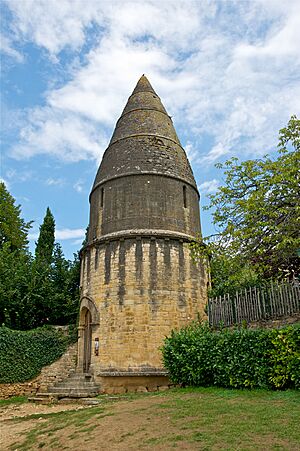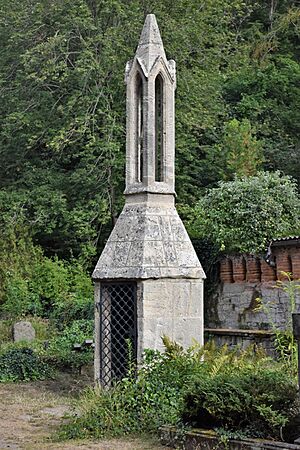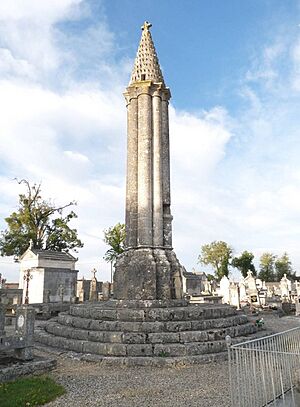Lanterns of the Dead facts for kids

Lanterns of the Dead (in French: Lanternes des morts) are special small stone towers. You can find them mostly in countries like Austria, France, Germany, Northern Italy, and Poland. They are linked to the history of Latin Christendom, which is a big part of Christian history in Europe.
Contents
What They Were For
These towers had small openings at the top. At night, a light would shine from these openings. This light helped people know where a cemetery, hospital, or even a place for people with leprosy was located.
Originally, these lanterns were built to warn people about the danger of getting sick. They also lit up cemeteries, where some people worried about ghosts or criminals hiding. Later, they were also built at important road crossings.
Lanterns in Different Countries
France
In France, these towers were usually round. They had a small door at the bottom. This door let people go inside to raise lamps using a pulley. This way, the light could reach the right height.
A very good example is in Cellefrouin (Charente). It has eight half-round columns on a base. It's topped with a cone-shaped roof decorated with fir cones. It has just one opening, facing the main road. Other examples can be seen in Ciron (Indre) and Antigny (Vienne).
Poland
You can find Lanterns of the Dead all over Poland. Some famous ones are in Kielce, Wrocław, and Kraków. These lanterns are strongly connected to the Middle Ages.
In 2021, a new Lantern of the Dead was built near Lublin in Dębówka. It was made in the old Romanesque style. This was the first such building in Europe in hundreds of years! Many old lanterns in Kraków have been changed over time. Most of them are now used as shrines or small chapels. The top opening, where lights used to be, has often been closed up. Also, statues of saints have been added to them.
Germany
In Germany, Lanterns of the Dead have been known since the 1200s. They were mostly found in the southern and southwestern parts of the country. Besides columns with lantern-like tops, some were also built into church walls. By the 1500s, people stopped using these lanterns much. However, the idea lives on today with grave candles. People still place these candles, for example, on All Souls' Day.
England
There is only one Lantern of the Dead left in England. It is in the churchyard at Bisley, Gloucestershire. It is known as the Poor Souls' Light.
Confusing Names
The real reason for these lanterns and how they were used can be a bit confusing. Some people think they are "lanterns of the Moors" instead of "lanterns of the Dead." This mix-up happened because the old French words for "the Moors" (les Maures) and "the dead" (les morts) sounded very similar.
Also, some of these lanterns are not near cemeteries. Their design sometimes looks like it came from the Middle East. This might be because of places like Al-Andalus (an old Muslim kingdom in Spain), Crusaders returning to France, or trade in the Mediterranean Sea.
For example, the "lantern of the Moors" in Vergèze, southern France, looks like chimneys from the Bakhchisaray Palace in Crimea. It's not near a cemetery. In fact, it's also called the "Saracen chimney." The "lantern of the Dead" in Carlux, also in Southern France, is also called a "Saracen chimney." Another example is the "lantern of the Moors" in Sarlat-la-Canéda. Its story is linked to a religious leader named Bernard of Clairvaux. He visited the city in 1147. Some believe Knights Templar built it, as shown by a sculpture of a horse and two crosses on the tower.
There are also "Saracen chimneys" (Cheminées sarrasines) in Bresse, a region in Eastern France. These are a typical local building style. It seems they just happen to have the same name by chance. The reason for their name is still a mystery. Some ideas about who brought this style include:
- Survivors from the Battle of Tours in 732.
- People who fled the Ottoman Turks in the 1400s.
- Burgundians who settled in Bresse in the 400s-500s.
- Monk-soldiers from the 1100s.
Another idea is that in the 1800s, "Saracen" or "Arab" could also mean "not real" or "made up."
See also
 In Spanish: Linterna de los muertos para niños
In Spanish: Linterna de los muertos para niños



